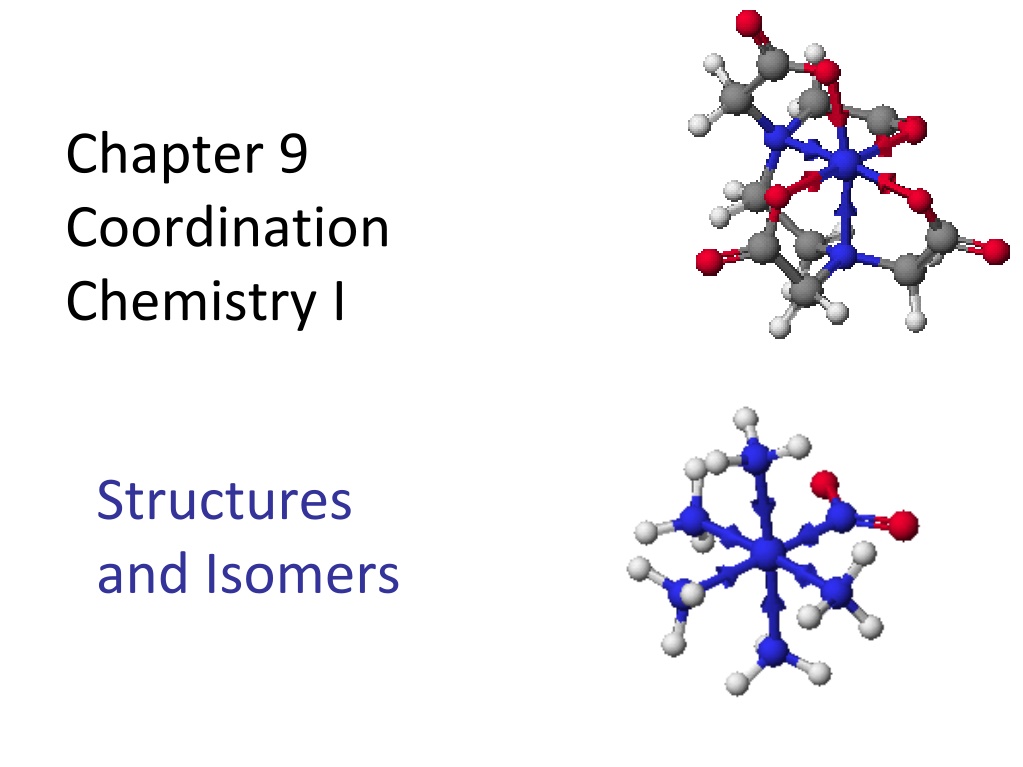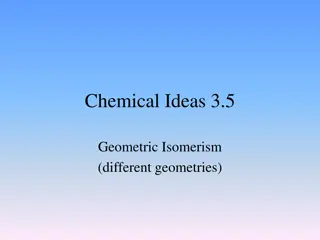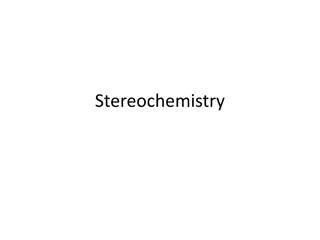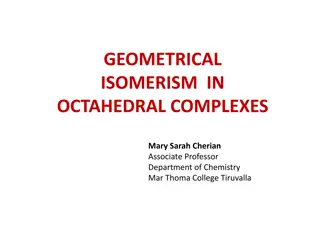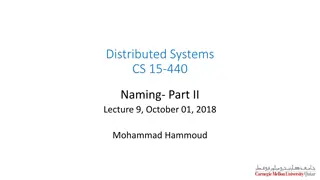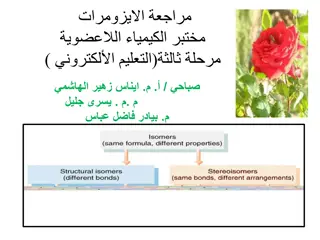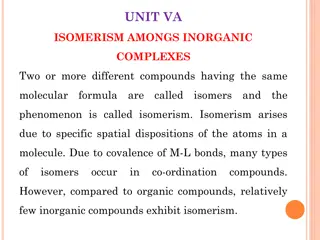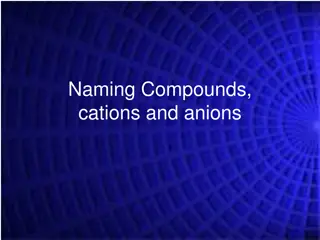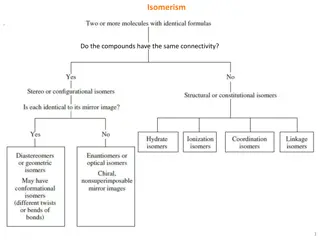Understanding Coordination Chemistry: Structures, Isomers, and Naming
Exploring coordination chemistry involves understanding structures, isomers, naming conventions, and common coordination numbers, all essential in studying coordination compounds. Coordination compounds consist of central metals, ligands, and charge balancing ions. Naming involves listing cations, ligands, and metals with Roman numerals for charge indication. Ligands are named alphabetically, with prefixes indicating the number of ligands. The coordination number determines geometric and optical isomers. Common structures range from CN 1 to CN 8, with examples of different coordination geometries for various metal ions.
Download Presentation

Please find below an Image/Link to download the presentation.
The content on the website is provided AS IS for your information and personal use only. It may not be sold, licensed, or shared on other websites without obtaining consent from the author. Download presentation by click this link. If you encounter any issues during the download, it is possible that the publisher has removed the file from their server.
E N D
Presentation Transcript
Chapter 9 Coordination Chemistry I Structures and Isomers
Coordination compounds Central metal, neutral or cation Ligand: neutral molecule or anion Ions for charge balance (if necessary) Coordination number = number of ligand attachments (commonly 4, 6, 5) Geometric and optical isomers possible Kf values: usually very large, >1010
Naming Coordination Compounds Cation + anion Ligands + metal in coordination compound Charge indicated by Roman numerals in parentheses If complex ion carries a negative charge, add -ate to the name of the metal Ligands are named in alphabetical order Prefixes indicate the number of ligands
Naming Ligands Neutral - aqua, ammine, carbonyl Anion - chloro, nitro, sulfato Cations are not common Chelating - multidentate ethylenediamine EDTA acac Prefix if ligand is complex (neutral or name contains a prefix) 2 (bis), 3 (tris), 4 (tetrakis)
Li2[CoF6] VCl3(NMe3)2 (NH4)3[Fe(CN)5CO] K3[Ni(CN)5] [Ru(bpy)3]Cl2 10
Some examples... Pt(NH3)42+ [Co(NH3)4(H2O)2]Cl2 Ligands shown in Tables in Chapter 9 Bridging ligands - Naming rules in Chapter 9 Exercises 9-1 and 9-2
Common Structures CN 1, 2, 3 - follow VSEPR Bulky ligands, filled d-orbitals Ag(I), Cu(I), Au(I) CN 4 - Tetrahedral or Square Planar d10 - tetrahedral; d8 - square planar CN 5 - trigonal bipyramid or square pyramid Similar energy CN 6 - octahedral + distorted octahedron CN 7, 8, ... more unusual, but known
Coordination Compound Isomers Stereoisomers geometric and optical isomers Structural hydrate, solvent, ionization, linkage isomers
Geometric Isomers CN 4 and 6 most common cis, trans fac, mer Isomer designations for compounds containing chelating ligands can get complicated (see textbook), we will not use
Geometric + Optical Isomers Octahedral geometry (consider monodentate ligands only): trans-pair method Mabcdef: Identify all trans pairs, then identify optically active isomers (ab)(cd)(ef), (ab)(ce)(df), (ab)(cf)(de), ...... Try Ma2b2cd Diastereomer + mirror image = pair of enantiomers Bidentate ligands? Use capital letters or manual method to identify geometric isomers M(AA)(BB)c2 How many isomers? How many chiral isomers?
Structural isomers What is inside the coordination sphere? CrCl3.6H2O has three hydrate isomers: non, mono, and di-hydrate Coordination isomers differ in what is inside the coordination sphere of each metal [Pt(NH3)4][PtCl4] vs. [PtCl(NH3)3][Pt(NH3)Cl3] Ionization isomers give different number of ions in solution or different ions in solution [Co(NH3)4(NO2)Cl]Cl [Co(NH3)4Cl2]NO2
Linkage Atom bonding to metal changes NO2- M-NO2 - nitro M-ONO - nitrito Can be converted by gentle heating SCN- bonds through S or N DMSO - S or O
Experimental Evidence: Magnetic Susceptibility 25
Magnetic Susceptibility g = constant S = spin quantum number (multiplicity) = 2(total spin) + 1 L = sum of the highest possible mlvalues following Hund s rule 26
Bonding: Sigma interactions
Bonding: Sigma interactions
Bonding: Sigma interactions
Ligand Field Splitting Trends Spectrochemical Series CO,CN- > phen,bpy > NO2- > en > NH3 > NCS- > H2O > F- > RCO2- > OH- > Cl- > Br- > I- Strong field Low spin Large o Weak field High spin Small o Slow Reactions (inert) Intermediate Fast Reactions (Labile)
Magnitude of Angular Overlap Interactions: Charge on Metal
Ligand Field Splitting Trends Spectrochemical Series CO,CN- > phen,bpy > NO2- > en > NH3 > NCS- > H2O > F- > RCO2- > OH- > Cl- > Br- > I- Strong field Low spin Large o Weak field High spin Small o Slow Reactions (inert) Intermediate Fast Reactions (Labile)
